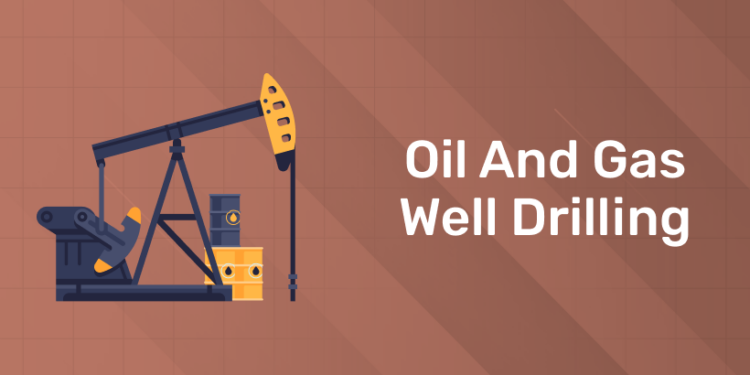Table of Contents
Drilling is the process of making wells by digging. It involves crushing rock, clearing particles, stabilizing walls, and stopping fluid entry. In this article we will learn about oil and gas well drilling.
We use rotating rigs with a cutting tool called a bit and steel pipes to do this. These rigs can be moved from one drill site to another on land and sea.
Get Certified! Get Confident! Join our Oil and Gas Course!
Oil and Gas Well Drilling
What is oil and gas well drilling?
Oil and gas well drilling is a process in which we dig holes on the earth to extract petroleum and natural gas. We use special machines to drill into the earth’s crust and reach the underground reservoirs where the oil and gas are stored. After drilling, we can extract the oil and gas for use.
How is it done?
History of Oil and Gas Well Drilling:
Early Methods:
- People dug shallow wells with hand tools to access surface oil.
- Ancient civilizations used bamboo poles for oil extraction.
Colonial Times:
- Edwin Drake drilled the first modern oil well in Pennsylvania in 1859.
- Spindle-Top discovery in Texas (1901) boosted oil production.
Technological Advances:
- Electric drilling rigs and hydraulic fracturing improved drilling.
- Offshore drilling platforms tapped into ocean oil reserves.
Modern Era:
- Today, advanced equipment and technology are used for drilling.
- Focus on efficiency, reducing environmental impact, and exploring new energy sources.
Modern Oil and Gas Well Drilling Methods:
Straight Drilling:
Description: Drill straight down into the ground using a rotating drill bit.
- Drill bit breaks through rock.
- The pumped fluid cools a bit and brings up rock pieces.
- Steel casing is inserted to support the hole.
Angled Drilling:
Description: Drill at an angle to reach oil and gas in hard-to-reach places.
- Start drilling vertically, then angle gradually.
- Allows access to multiple reservoirs from one spot.
Fracking:
Description: Pump fluid into the ground at high pressure to crack rocks and release oil and gas.
- Fluid breaks rock, sand holds cracks open.
- Helps oil and gas flow better.
Offshore Drilling:
Description: Drill for oil and gas in the ocean.
- Platforms anchored to the ocean floor.
- Drill wells vertically or at angles from the platform.
- Safety measures to protect marine life and prevent spills.
Advantages of Oil and Gas Well Drilling:
Energy Security:
- Ensures we have enough energy without relying too much on others.
Economic Growth:
- Creates jobs and money for local areas and governments.
Access to Resources:
- Gives us access to lots of oil and gas underground.
Technology Improvement:
- Helps us invent better ways to get oil and gas out of the ground.
Stable Energy Supply:
- Keeps our energy supply steady, along with renewable energy.
Money-Making:
- Makes lots of money for countries and companies.
International Trade Boost:
- Helps trade between countries, making the world economy stronger.
Many Uses:
- Supports industries with things like fuel and materials.
Building Things:
- Helps us build things like pipelines and refineries.
Emergency Help:
- Provides important help during emergencies and disasters.
Limitations of Oil and Gas Well Drilling:
Environmental Impact:
- Harms ecosystems, pollutes water, and contributes to climate change.
Resource Depletion:
- Overuse can lead to future scarcity of resources.
Health Risks:
- Exposes workers and communities to harmful chemicals and pollutants.
Accidents and Spills:
- Potential for devastating environmental and economic damage from accidents.
Community Disruption:
- Causes noise, traffic, and other disturbances in communities.
Dependency on Fossil Fuels:
- Hinders transition to cleaner energy sources.
Geopolitical Tensions:
- Can lead to conflicts over control and access to resources.
Regulatory Challenges:
- Enforcing safe practices requires robust regulations.
Public Opposition:
- Faces resistance due to environmental and social concerns.
Long-Term Consequences:
- Impacts like habitat destruction may not be fully understood until later.
Get Certified! Get Confident! Join our Oil and Gas Course!
Job Opportunities in Oil and Gas Well Drilling:
| Job Title | Job Role | Qualifications Required | Salary Range (per year) |
| Drilling Engineer | Plans drilling operations | Bachelor’s degree in engineering or related field | INR 8,00,000 – INR 15,00,000 |
| Drilling Supervisor | Oversees drilling work | High school diploma or equivalent; relevant experience | INR 6,00,000 – INR 12,00,000 |
| Driller | Operates drilling equipment | High school diploma or equivalent; on-the-job training | INR 4,00,000 – INR 8,00,000 |
| Rig Manager | Manages drilling operations | Bachelor’s degree in engineering or related field | INR 10,00,000 – INR 20,00,000 |
| Derrickhand | Assists with drilling tasks | High school diploma or equivalent; on-the-job training | INR 3,00,000 – INR 6,00,000 |
| Mud Engineer | Manages drilling fluid | Bachelor’s degree in engineering or related field | INR 6,00,000 – INR 12,00,000 |
| Geologist | Studies underground formations | Bachelor’s or Master’s degree in geology or related field | INR 8,00,000 – INR 15,00,000 |
| Safety Coordinator | Ensures safety procedures | Bachelor’s degree in occupational health and safety or related field | INR 6,00,000 – INR 12,00,000 |
| Environmental Specialist | Monitors environmental impact | Bachelor’s degree in environmental science or related field | INR 6,00,000 – INR 12,00,000 |
| Equipment Technician | Repairs drilling equipment | Vocational training or certification in equipment maintenance | INR 4,00,000 – INR 8,00,000 |
Oil and Gas Well Drilling: Conclusion
This article discusses about oil and gas well drilling. Its history, different methods by which it is done. And job opportunities are available in this field.
Entri’s Oil and Gas Course provides all the essentials for success in the industry. Gain valuable hands-on experience to secure a good job.
Frequently Asked Questions
What is the process of drilling an oil or gas well?
Drilling an oil or gas well involves using specialized equipment to create a hole in the earth’s surface, typically using a rotary drilling rig. The process includes drilling through layers of rock, casing the well to prevent collapse, and extracting oil or gas from underground reservoirs.
How deep are oil and gas wells typically drilled?
The depth of oil and gas wells can vary widely depending on factors such as the location of the reservoir, geological formations, and the type of drilling technology used. Wells can range from a few hundred feet to several miles deep.
What safety measures are in place during oil and gas drilling?
Safety is a top priority in oil and gas drilling operations. Measures include rigorous training for workers, regular equipment inspections, adherence to safety protocols, and emergency response plans. Regulatory agencies also enforce safety standards to ensure compliance and minimize risks.











